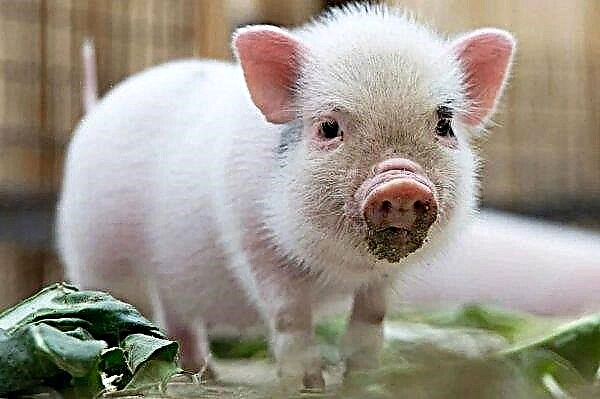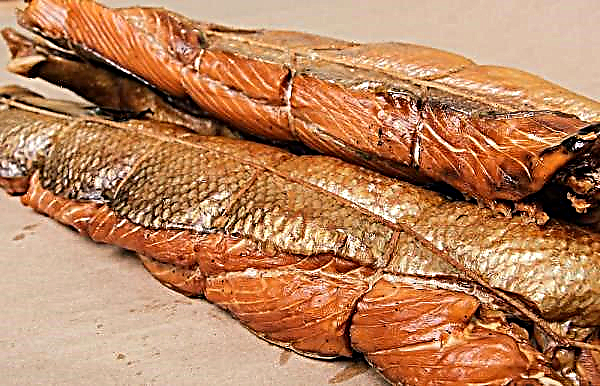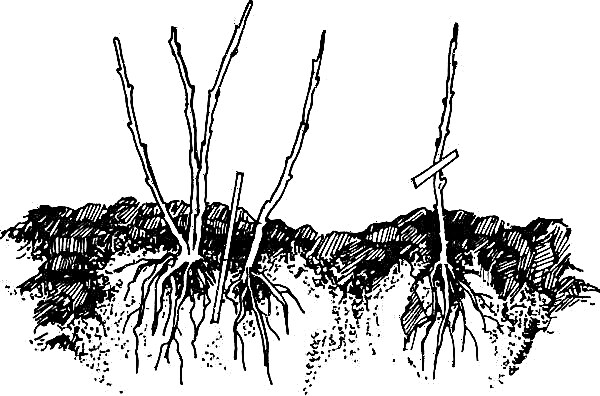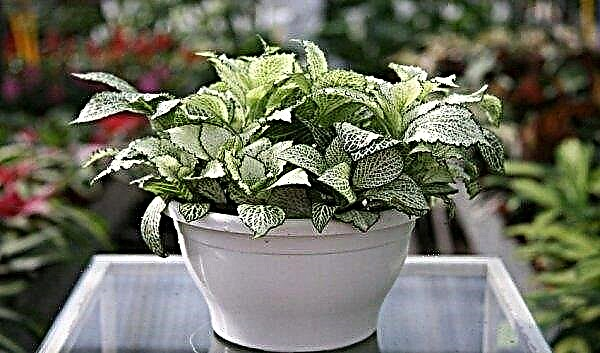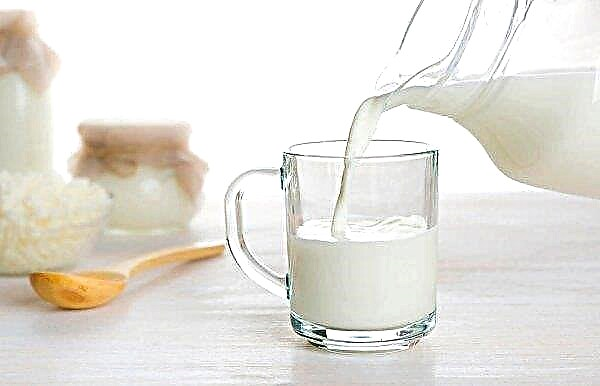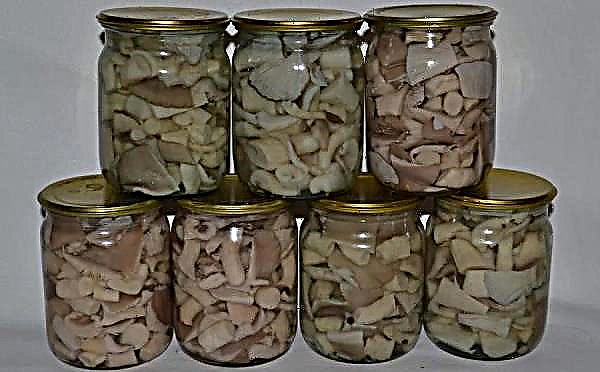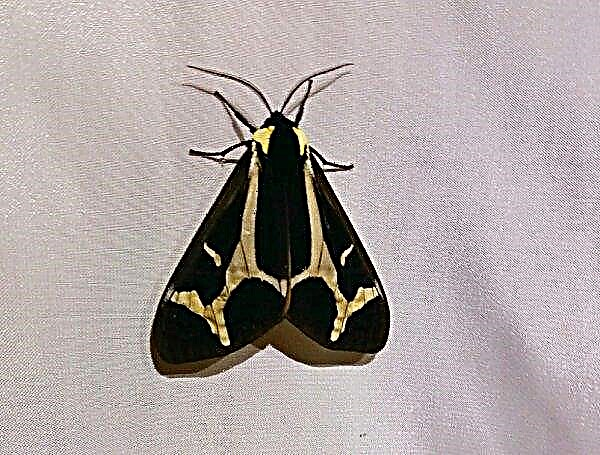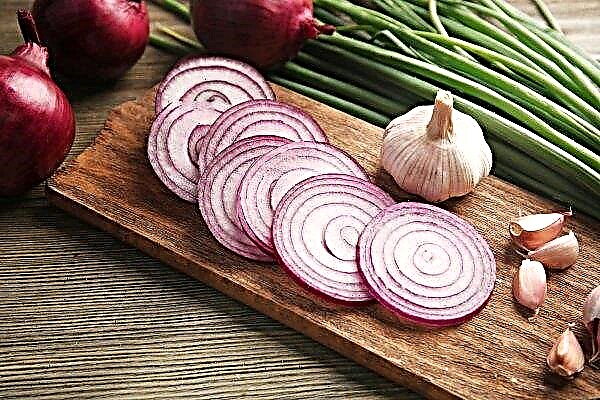The hybrid form of cucumbers has long been successfully cultivated by gardeners and gardeners in protected ground and in open beds. If you chose the Parisian Gherkin hybrid for planting, then in the article you will find useful tips on growing it.
Characterization and description of the variety
To begin with, we offer to get to know the hybrid better and learn about its productive, taste and other qualities, as well as consider its advantages and disadvantages.
Bred Paris Gherkin by Russian breeders. In 2006, it was introduced to the State Register of the Russian Federation with a recommendation for cultivation in the Central and Central Black Earth regions.
Taste qualities
Cucumbers Parisian gherkin are distinguished by excellent taste. They are characterized by juiciness, density. They are crispy. There is no bitterness in taste and voids inside.
Did you know? The culture of growing cucumbers originated in the ancient Greeks and Romans. In ancient Rome, the first greenhouses were built to cultivate this plant in order to bring its fruits to the table to the emperor Tiberius, who loved them very much.
Description of the bush and fruits
Cucumber bushes are tall. The lashes are not long. Branching is average. Type of flowering is mainly female. Ovaries appear along the entire length of the shoots. The length of the cucumbers is 10–12 cm, the average weight is 60–85 g.
The length of the cucumbers is 10–12 cm, the average weight is 60–85 g.
Fruits are shaped like cylinders or have a fusiform shape. The skin is covered with large tubercles, pubescence and black spikes. Her color is saturated green with white stripes.
Grade stability
When breeding a hybrid, breeders managed to tolerate droughts and hot temperatures well, resist pathogens of cladosporiosis, powdery and downy mildew, mosaics, olive spotting.
Productivity
Hybrid productivity with proper planting and quality care was noted at a high level - 360 c / ha. Bushes are completely pollinated by bees.
 The output of marketable products is 84%.
The output of marketable products is 84%.
Advantages and disadvantages
- Gardeners who already had experience in cultivating the hybrid Parisian Gherkin, note the following advantages:
- high level of productivity;
- excellent taste and marketability of cucumbers;
- early ripening;
- resistance to drought;
- uniform fruiting;
- the ability of the fruit to tolerate transport;
- strong immunity to many diseases;
- small fruit size, which is good for canning.
- The disadvantages include:
- low yield of marketable products;
- the tendency of the fruit to barrel (overgrow);
- the need for mandatory garter.
Optimal growing conditions
In order for the cucumbers to develop correctly and successfully bear fruit, it is necessary to allocate a suitable plot for their planting. Since the described culture is light and thermophilic, the place should be well lit and warmed up by the sun, and also be sheltered from the winds. The recommended location of the beds for proper lighting and fruiting is from north to south.
Important! At one place, cucumbers can be cultivated no longer than two years in a row. On the beds, where plants from the pumpkin family previously grew, cucumbers can be returned after 4 years.
To reduce the risk of contracting diseases and pests and get the maximum number of fruits, it is important to follow crop rotation rules. According to them, this crop should be planted in the beds where cabbage, lettuce, potatoes, and tomatoes were previously grown. Do not place the plant after cucumbers, carrots, zucchini, gourds. Cucumbers grow well in fertilized light and loose soil with neutral acidity.Since the Parisian gherkin is a hybrid, its seeds need to be purchased only in a specialized store. Collected with your own hands or bought with hands for planting are unsuitable, since they do not preserve the qualities of the mother plant. Acquired seeds neither need disinfection nor soaking. These procedures have already been done by the manufacturer.
Cucumbers grow well in fertilized light and loose soil with neutral acidity.Since the Parisian gherkin is a hybrid, its seeds need to be purchased only in a specialized store. Collected with your own hands or bought with hands for planting are unsuitable, since they do not preserve the qualities of the mother plant. Acquired seeds neither need disinfection nor soaking. These procedures have already been done by the manufacturer.
Growing and caring for the Paris Gherkin
The described hybrid form can be grown using seedlings (this will help to achieve an earlier harvest) and by sowing seeds directly on an open bed.
Direct landing in open ground
Before planting cucumbers on open beds, the site must be prepared. Do this in 2 stages: autumn and spring. In the autumn, the place is cleaned of plant debris and digged well. Then prepare high warm beds. First, they dig a trench to a depth of 20–25 cm and a width of 70 cm. A ditch 30–35 cm deep is made in its center, into which leaves, peat, sawdust, straw, grass are laid (15 cm layer). The next layer is laid with fresh manure. In spring, a layer of soil fertilized with minerals is placed on it. Then the bed is covered with a film on the arcs in order to warm it.
Important! If cucumbers of the Parisian gherkin are cultivated in a greenhouse, it is necessary to take care of the access of pollinating insects to them or to pollinate independently by artificial means.
If autumn preparation was not carried out, then in the spring, 2-3 weeks before planting, rotted manure, mullein, chicken droppings or compost with wood ash and nitrophosus are brought to the site. For warming, the bed is also covered with a film.
Sowing seeds in the soil under the film is produced from about 15 to 25 May. When grown without film, planting is carried out from May 20 to May 27. Exact dates will depend on regional circumstances and weather conditions. The earth at a depth of 12 cm at this time should already warm up to + 15 ° C, and the air during the day - to +18 ... + 26 ° C. The procedure is planned on a calm sunny day. Before the procedure, the prepared furrow is watered abundantly.
Video: Sowing cucumber seeds in open ground
Sowing technology is as follows:
- Place the seeds in the furrow using the 50 × 30 cm pattern. Seeding depth is 3 cm.
- Sprinkle the seeds with a small layer of soil.
- Tamp the ground with light movements.
- To carry out watering.
- Cover the planting with a film, stretching it over the beds or setting arcs.
Seedling cultivation
Sowing seeds for seedlings is carried out 3-4 weeks before the planned move to a permanent place. To grow sprouts, it is necessary to purchase hybrid seeds, planting soil and containers. Soil substrate can also be made with your own hands. The main requirements for it are nutrition, friability, lightness, moisture.
Cucumber seedlings do not like picking, so sowing seeds should be carried out immediately in separate pots or peat tablets. 1-2 seeds are placed in filled containers. Depth of embedment - 2 cm. At first, crops require a temperature of + 22 ... + 28 ° C and good lighting. After the appearance of sprouts, the temperature must be reduced to + 18 ... + 20 ° C. Leaving consists in periodic moistening of the upper soil layer.
At first, crops require a temperature of + 22 ... + 28 ° C and good lighting. After the appearance of sprouts, the temperature must be reduced to + 18 ... + 20 ° C. Leaving consists in periodic moistening of the upper soil layer.
Shoots in which the root system is well developed can be transplanted into open ground, the stems have a height of about 30 cm, there are 3-4 leaves. Planting scheme - 4 plants per 1 m².
Watering and feeding
Cucumbers should be watered moderately and regularly. Before the appearance of flowers, it is recommended to carry out one hydration in 5–7 days, spending 3–6 liters of water per 1 m². During the formation of fruits, watering is quickened to one in 2-3 days. The volume of fluid is increased to 6-12 liters.
Humidification is carried out using a watering can in the evening or morning hours. When carrying out the procedure, it is necessary to ensure that moisture does not get on the ground organs of the plant.
To increase the yield and proper development of cucumbers, they are fed with fertilizers. The best way for this culture is the alternation of organics (mullein) and mineral mixtures (ammonium nitrate, potassium salt, superphosphate). For the season, it is recommended to make 3 root top dressings: at the moment of appearance of 2-3 leaves, after 14-18 days, before the closure of the lashes.Important! Watering cucumbers produce water with a temperature of at least + 18 ° C. Humidification with cold water leads to improper plant development and increases the risk of fungal diseases.
If necessary, they also resort to foliar top dressing. One of the most commonly used formulations is a mixture of superphosphate (12 g), potassium chloride (7 g), urea (5 g), water (10 l).
Bush formation
Since the bushes of the hybrid Parisian gherkin are indeterminate, they need to be grown on a trellis or net. So cucumbers will be evenly lit by the sun, less sick due to the lack of contact of fruits and leaves with soil. In addition, tied plants are easier to care for and harvest from them. For the first time, the bushes are tied when they reach a height of 40–45 cm.
To stimulate the growth of side shoots, cucumbers can be planted. This procedure is optional. It has a beneficial effect on the development of plants - reduces the load, increases productivity and accelerates the ripening of fruits.
The first stepsoning is carried out after the formation of 5-7 leaves. The lateral shoots are removed from the plants, leaving 2-3 stems with ovaries by pinching over the second leaf. Ovaries and shoots in the sinuses of the first four leaves are also torn. The second time, stepsons are removed after the formation of 9 leaves on the plant, the third after 11.
Pest and Disease Control
Cucumber Parisian gherkin is rarely sick. Diseases affect him only in case of improper agricultural technology. The most dangerous for him is bacteriosis. It leads to the appearance of brown spots on the ground organs of the plant, deformation of the fruit, the formation of ulcers on them. For the treatment and prevention of the disease, spraying with Bordeaux liquid is used (0.5-0.7%).
Of the pests for cucumbers, the danger is:
- Sprout fly. The larvae of this insect cause enormous damage to seeds and young plants. To get rid of it, the Zenkor, Hurricane Forte, and Spark insecticides must be treated 3 times.

- Spider mite. This insect attacks cucumbers when it is hot and dry outside. Its presence is indicated by a web on lashes and foliage. There are small holes on the top sheet plate. Soon the leaves will dry out. Against ticks apply "Fundazol", "Fitoverm", "Bitoxibacillin", "Actofit", "Fufanon", colloidal sulfur.

- Aphid. Symptoms of infection: curling leaves, falling flowers and foliage. With a small number of insects, they are treated with a soapy solution, sprinkling the beds with wood ash, an ash-tobacco mixture. With severe infection resort to the use of drugs "Inta-Vir", "Decis."

- Thrips. These small insects settle on the leaves and drink plant juice, as a result of which small punctures can be seen on them. With a minor lesion, treatment with folk remedies, for example, infusion from onion husks, helps. For a massive defeat, spraying with Fufanon, Fitoverm, Iskra M, and Commander Maxi is necessary.
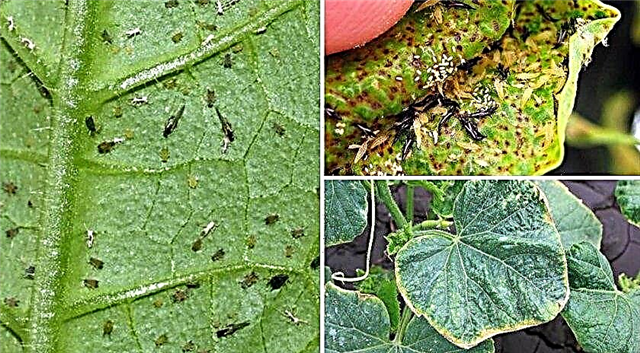
- Nematode. Small worms live underground and infect the root system, leading to the appearance of growths on the roots, improper development of the plant, and a decrease in the quality and volume of the crop. Cucumbers look depressed, their leaves are twisted. With a severe defeat, the plant will need to be disposed of. With timely detected infection, when the roots are not damaged much, treatment with "Mercaptophos", "Phosphamide", "BI-58" will help.

Harvesting and storage
When cucumbers begin to bear fruit en masse, the beds for ready-to-pick greens should be inspected twice a day - in the morning and evening hours. This is necessary in order to prevent the fruits from overripening, which in this state become unfit for food, lose their taste and market characteristics - they turn yellow, rough, soften, barrel.
Did you know? In the botanical classification, cucumber is considered a fruit. According to botany, all the juicy fruits that produce seeds are fruits.
Cucumbers need to be twisted or cut with secateurs, leaving the stalks on the lashes. It is strictly forbidden to pull them, pull, turn over leaves and vines. So you can damage the plant and have a negative impact on its growth and development. During harvesting, not only ready-to-eat cucumbers need to be cut, but also overripe, damaged, deformed. By removing them, you can unload the plant and give it an incentive to set new fruits.
During harvesting, not only ready-to-eat cucumbers need to be cut, but also overripe, damaged, deformed. By removing them, you can unload the plant and give it an incentive to set new fruits.
Freshly harvested cucumbers must immediately be placed in cool conditions. At a temperature of + 6 ... + 8 ° C and a humidity of 85–95%, they can be stored for 1-2 weeks. In the refrigerator, they must be stored in an unpressurized bag, in the vegetable compartment. In the cellar - in wooden, plastic boxes or trays.
At room temperature, after two days, cucumbers lose their taste and a greater number of valuable elements. To save cucumbers for the winter, they can be salted, canned, or frozen.
So, subject to the rules of agricultural technology, it is not difficult to grow and get a crop of fruits of a hybrid form. Especially the variety will appeal to those who love canned cucumbers. The small size of the gherkins makes them ideal for winter harvesting.





